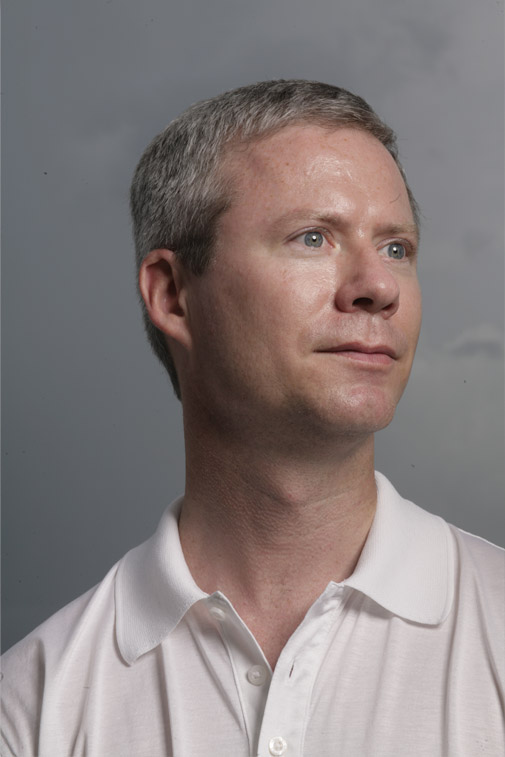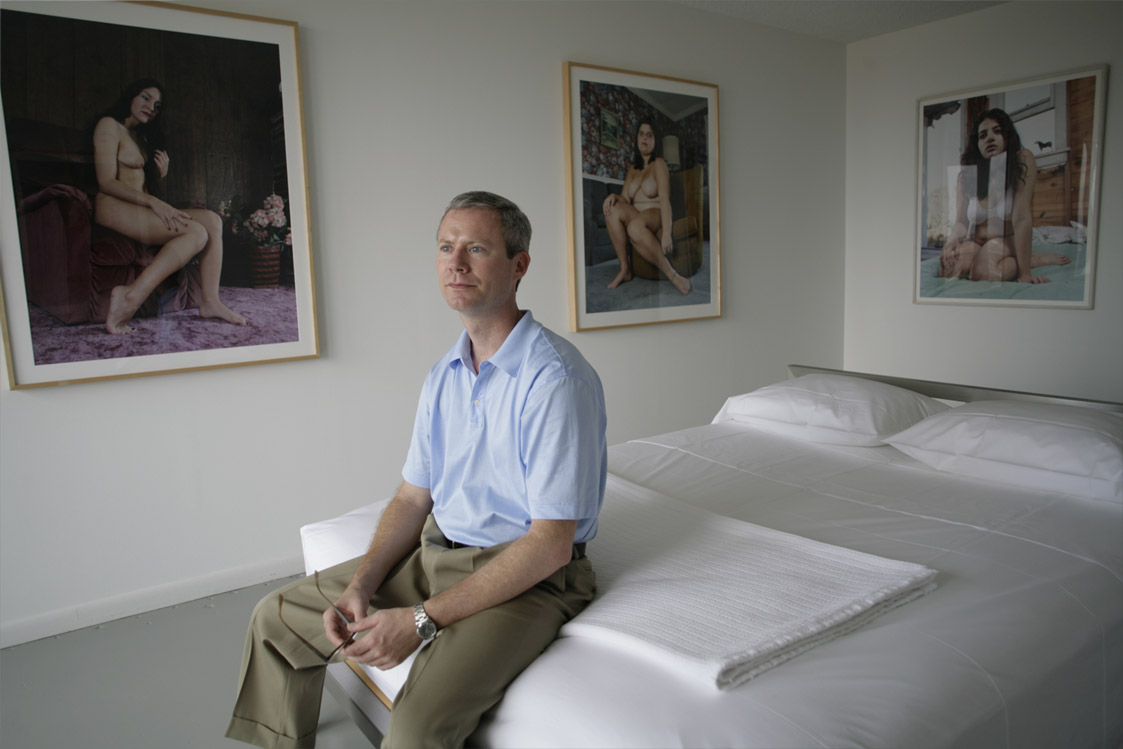john morrissey

Foreseeing Fortune
By Melissa Cantor, Photographs by Alexander Neumann A West Palm Beach lawyer who moonlights as a collector of young emerging artists, JOHN MORRISSEY has a knack for spotting fresh talent. A step ahead of the game, Morrissey tells us which artists will be popular and valuable years into the future. Known for recognizing emerging artists and trends before prices skyrocket, John Morrissey is the self-proclaimed creator of terms like Stoner Surrealism, Pathetic Aesthetic and Urban Chic. The 37-year-old probate lawyer, who delves into art collecting as a means of relaxation, admits "some art figures might find these terms inappropriate." But as Morrissey's collection -- not to mention his home -- indicate, he is not one prone to convention. One of his favorite trends is Post-Feminist Girlie Art, a movement in which women reclaim the pleasure men have had for centuries in depicting the female form. "It's interesting to see a woman from a woman's perspective," Morrissey says -- and he means it. While his stark, white home serves as a gallery exclusively for the works of contemporary women artists from Su-en Wong and Carol Bove to Loretta Lux and Hilary Harkness, his bedroom is where his passion is truly evident. In a room adorned only by a white bed and a white crepe lamp, hang several 44 1/2 - by - 35" documentary photographs from Katie Grannan's "Poughkeepsie Journal" series -- of large, naked, minimally groomed women. "Ah, yes," Morrissey says. "The ladies. I know you'd love it." WHITEWALL: Although you have an impressive art collection that's frequently cited among the top collections of contemporary art in the U.S., you are a lawyer currently starting your own law firm. JOHN MORRISSEY: Yes, I am a probate lawyer, and I do a lot of estate planning work, and handling settlements when there is a death in the family. WW: How and when did you begin collecting? JM: When I was at Georgetown Law School. Reading case law gets boring after you do it for hours on end, so my brief reprieves were spent in the periodical section of the library reading art magazines, and I read enough to engender an interest. The practice of law can be stressful and involves constantly reading text, so it's a relaxing change of pace to behold a work of art. It's easier to just look -- though of course it's harder to interpret, because there's no text there to interpret for you. WW: Is it true that you've never taken an art class? To what do you attribute your skill to identify emerging artist -- and know to invest in them -- before the majority of the art world has really taken note? JM: No, I've never taken an art class. Obviously I have to like the work in order to buy it, but there are a number of artists whose work I enjoy looking at but don't purchase, because I don't see that there's the infrastructure there for them to have an enduring career. Mainly I attribute my success to the investment in time when studying an artist and their collegiate careers. I spend a lot of time on the Internet, learning where a young artist received his or her MFA, what galleries are representing them, where they are about to participate in group shows and what curators are interested in their work. It's all a basket of information that you put together in an attempt to determine who might be the next Dana Schutz or Kehinde Wiley. WW: Have you ever bought a piece solely based on instinct or a connection with the work, or is research always a part of your process? JM: For me, most of the fun actually is the research, so I can't say that I've ever bought unknowingly or unwittingly. I like to know what I'm getting into. WW: Is there a recurring person or institution -- whether that be a school, a dealer, or a gallery -- among the artists that you purchase? JM: I've known collectors who will trust a certain dealer and buy a lot of their work, but I don't have a tendency to do that. I like to do my own independent research, and that's the fun part of it. However, I've noticed that over time I have bought a lot of art through Deitch Projects, and more recently from Rhona Hoffman's gallery. I buy mostly from the galleries that are known for showing young artists. I collect young and have on a number of occasions collected before artists are even represented by galleries. That was true in the case of Hilary Harkness and Su-en Wong. WW: What specifically did you see in their works that enabled you to foresee enduring careers for them? JM: Because I collect young Americans, I try to look for trends in art in the U.S. One that figures very highly is what I refer to as Post-Feminist Girlie Art, and it fairly well categorizes artists like Hilary Harkness and Su-en Wong. While for centuries you had men who reveled in women's physicalities, now you have these young ladies issuing a demand to do that for themselves. It started with Sue Williams, moved to Cecily Brown and her abstract orgies, and then it developed into Su-en Wong and Hilary Harkness. They are having fun with it, in a postfeminist way, and I quite like their work. I think they may become progenitors of this movement. WW: Another trend you identify is Urban Chic. Can you describe that movement? JM: We live in a hyper-consumptive culture, and hip-hop is synonymous with that consumerism, with the "bling." The artists in this movement have been picking up on that. Kehinde Wiley is doing an extraordinary job of looking at it from an art historical perspective. For example, in art, the eighteenth-century European leisure class was painted with majesty. They were adorned with crests, and Wiley is incorporating that. He is taking young African Americans from Harlem and placing them within that field of power, by putting them in the poses you'd see in those paintings. All the jewels are a substitute for the crests and emblems. In hip-hop culture, the Bentley Coupe figures largely -- and that's a substitute for the horseless carriage. I would also consider Mickalene Thomas as part of the Urban Chic movement. I have a number of her paintings. The surfaces are adorned with sequins and rhinestones, and superficially you have this dazzle of bling, but virtually all of her works depict the black female who appears to be living a hardened life and is in a depressive system of despair. So the superficial dazzle is really just that, entirely on the surface. To the extent that there is glamour, it's a hardened glamour. Ergo, the term Urban Chic. WW: What are some of the other trends you've identified? JM: A lot of young emerging artists are doing what I call Stoner Surrealism and using a surrealist base and incorporating Pop Art or photorealistic art into it, using plastic owls and snowmen and bubbles to represent suburban culture. One young artist who I think is very good right now is Todd Hebert. There's also a movement I call Pathetic Aesthetic, which reflects an American wasteland, the angry, confused, seamy underside of American life. WW: What are some of your recent purchases? JM: I recently bought two very large paintings by a young girl who just graduated from Columbia, Natalie Frank. She does large figurative paintings, mainly allegorical. After I bought her pieces, she signed with Mitchell-Innes & Nash. Most recently, I purchased a work by Aleksandra Mir, who does Sharpie drawings of maps and airplanes. I gravitate mostly to paintings because in this market I find that drawing has become surprisingly high-priced, as have photographs, relative to the traditional paint on canvas, but she's well-schooled, well-positioned, and does very good work. WW: You buy paintings at a lower price level, as opposed to when they reach six figure asking prices. Is this decision based made solely from an investment perspective, or is there an element of philosophy behind it? JM: As a young collector,it's in part what you can afford. But to the extent that you look at art as a commodity, it's safer to be buying at a lower price level and to buy two or three years before the artists become successful, than to buy at a six-figure level -- at least when it comes to young artists. In 1999 I bought a Cecily Brown painting for $11,000. She just had a painting of the same size and from the same show sell for $956,000. Even if I were at a level where I were buying million-dollar paintings, I would feel much less safe buying a Cecily Brown, at her age, for that price. Rather than purchase a single expensive piece from a hot artist, I could buy maybe eight to ten pieces from a younger artist, and it makes sense for me to do that. I suppose some could argue it's riskier to buy from a young artist because they don't have a career history yet, but that's where all the research I do comes in. WW: You mentioned that you find drawings and photographs surprisingly high-priced. JM: Yes, and that's not to say I don't collect drawings and photographs at all. I have a number of pieces by Loretta Lux and artists who have been referred to as the Yale school of photographers -- Katy Grannan, Malerie Marder. But I do think that the prices for drawings and photographs are high, and that's the function of the market that we're in. People want what's young and hot, almost like having the latest Prada bag. Of course that brings into question the kind of longevity these artists can have, but I can't say I haven't fallen prey to that impulse myself. In fact, it's been key to my success. Article Source: Cantor, Melissa. "Foreseeing Fortune." Whitewall, Fall 2006, pp. 106 - 109. |


